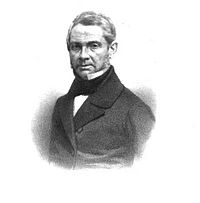José Antonio Saco facts for kids
Quick facts for kids
José Antonio Saco
|
|
|---|---|
 |
|
| Born |
José Antonio Saco
May 7, 1797 |
| Died | September 26, 1879 (aged 82) Spain
|
| Nationality | Cuban |
|
Notable work
|
Historia de la esclavitud |
José Antonio Saco (born May 7, 1797 – died September 26, 1879) was a very important Cuban figure in the 1800s. He was a statesman, writer, and historian. He also worked as a social critic and publicist. Saco was known for his strong ideas and his fight against slavery.
Contents
Early Life and Education
José Antonio Saco was born in Bayamo, Cuba, on May 7, 1797. When he was 12 years old, in 1809, he went to the Seminary of San Carlos in Havana. There, he studied under the guidance of Félix Varela, a well-known teacher.
In 1821, Saco became a philosophy professor at the same school. He took over the teaching position of his old teacher, Félix Varela.
Travels and Writings
From 1824 to 1826, Saco traveled to the United States. In 1828, he returned to New York City. While there, he focused on writing. He started a weekly magazine called Mensajero Quincenal. This magazine shared news about science, politics, and literature.
In 1832, Saco came back to Havana, Cuba. He became the editor of Revista Bimestre Cubana. This magazine published articles on many topics. These included immigration, ending slavery, statistics, and education. He worked there until 1834.
During this time, he also managed the College of Buena Vista. In 1834, he was forced to leave Cuba. This happened because of his liberal ideas and his strong anti-slavery beliefs.
Awards and Recognition
In 1833, Saco wrote many essays about roads and living conditions in Cuba. He also wrote about issues like homelessness. His writings won top prizes from the Sociedad Patriótica (Patriotic Society).
Political Work and Exile
In 1836, José Antonio Saco was chosen to represent eastern Cuba. He was meant to join the Spanish Cortes, which was like a parliament in Spain. However, the government in Madrid stopped the colonies from having representatives. So, Saco could not take his seat.
Soon after, he decided to travel to other countries. He went to Europe and lived in Spain for a while. There, he translated a famous book on Roman Law from Latin into Spanish. His translation was published many times.
In 1838, he published a book in Madrid called Paralelo entre Cuba y algunas colonias inglesas. This book compared Cuba to some English colonies.
After that, he traveled more around Europe. He visited Germany, Italy, Austria, Portugal, and finally France.
Life in Paris
In 1840, Saco settled in Paris, France. In 1845, he published Supresión del tráfico de esclavos en Cuba. This book argued for stopping the slave trade in Cuba. It made many slave owners very angry. Because of this, it became harder for him to return to Cuba.
In 1848, he published Ideas sobre la incorporación de Cuba a los E. U. in Paris. In this book, he shared his thoughts on Cuba joining the United States. He was partly against Cuba becoming part of the U.S. This book was quickly translated into English and French. It was also discussed by American newspapers.
In 1851, his book La situación política de Cuba y su remedio was published. A few years later, in 1853, he published La cuestión Cubana.
In 1854, Saco had a chance to return to Cuba. There was a special pardon that allowed people to come back. However, he did not return until 1861. His goal then was to start a newspaper in Madrid. This newspaper would defend Cuba's interests while he lived in France.
Later Years and Legacy
In 1866, Saco was chosen in Santiago de Cuba to be a delegate in Madrid. His job was to push for political changes for Cuba. He was part of a special committee that looked into these reforms. He played a very active role in this committee.
In 1878, he was chosen again by Santiago de Cuba to join the Spanish Cortes. But he passed away suddenly before he could take the position.
In his final years, Saco began writing a very large work. It was called Historia de la esclavitud desde los tiempos más remotos (History of Slavery from the Earliest Times). Several parts of this book were published before he died.
Some of his other works include Historia de la esclavitud entre los Indios (History of Slavery Among the Indians). He also wrote many articles on different topics. These articles were later collected into a book called Colección de papeles varios in 1882 in Havana. Other smaller works were put together into Papeles de Saco (Saco's Papers) and Colección póstuma (Posthumous Collection).
See also
 In Spanish: José Antonio Saco para niños
In Spanish: José Antonio Saco para niños

